The screwdriver market is estimated to be valued at USD 4.9 billion in 2025 and is projected to reach USD 7.8 billion by 2035, registering a compound annual growth rate (CAGR) of 4.7% over the forecast period.
The screwdriver market is valued at USD 4.9 billion in 2025 and is projected to grow to USD 7.8 billion by 2035, with a CAGR of 4.7%. Between 2021 and 2025, the market grows gradually from USD 3.9 billion to USD 4.9 billion, with values increasing from USD 4.1 billion, 4.3 billion, 4.5 billion, and 4.7 billion. This steady growth is driven by the expanding demand for power and hand tools in both consumer and industrial applications, including construction, automotive, and DIY projects.
Between 2026 and 2030, the market progresses from USD 4.9 billion to USD 6.5 billion, with intermediate values reaching USD 5.2 billion, 5.4 billion, 5.7 billion, and 5.9 billion. This phase reflects continued adoption of advanced screwdriver models, with innovations such as cordless and rechargeable options, improved ergonomics, and added functionality like torque control. As the market matures, the pace of growth begins to decelerate, moving towards a saturation point.
From 2031 to 2035, the market reaches USD 7.8 billion, passing through USD 6.2 billion, 6.5 billion, 6.8 billion, 7.1 billion, and 7.5 billion. During this period, growth begins to slow as the market approaches saturation, with incremental increases driven by replacement demand and innovation in features. The saturation point reflects a mature market where the majority of consumers and industries have adopted advanced screwdriver models, and growth is fueled mainly by product upgrades and specialized tool applications.
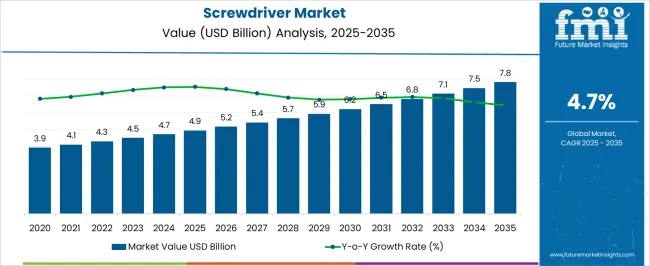
| Metric | Value |
|---|---|
| Screwdriver Market Estimated Value in (2025 E) | USD 4.9 billion |
| Screwdriver Market Forecast Value in (2035 F) | USD 7.8 billion |
| Forecast CAGR (2025 to 2035) | 4.7% |
The hand tools market is a major driver, accounting for around 25-30%, as screwdrivers are one of the most commonly used tools for a variety of applications, ranging from home improvement to industrial tasks. The power tools market plays a significant role, contributing approximately 20-25%, with the growing popularity of electric screwdrivers and drills in both professional and DIY settings boosting demand. The construction and building materials market is also a key contributor, accounting for about 15-20%, as screwdrivers are essential for assembling structures, installing fixtures, and working with various building materials, making them indispensable on construction sites.
Additionally, the automotive aftermarket market contributes around 10-12%, as screwdrivers are widely used in vehicle maintenance and repairs, both by DIY enthusiasts and professionals. Finally, the industrial tools market accounts for approximately 8-10%, as screwdrivers are crucial in manufacturing, assembly lines, and machinery maintenance, where high-performance tools are necessary for efficient operations. These parent markets collectively highlight the widespread and diverse demand for screwdrivers across industries such as hand tools, power tools, construction, automotive, and industrial sectors.
The screwdriver market is witnessing consistent growth, supported by increasing consumer demand across both professional and household applications. Expansion in global infrastructure development, rising DIY culture, and growing home improvement activities are contributing to market momentum. Innovations in design ergonomics and material durability are improving user convenience, which is boosting adoption across various end-user segments.
The proliferation of e-commerce platforms has also enhanced accessibility to a broad range of screwdriver products, especially in emerging markets. Rising urbanization and increased focus on residential maintenance are further reinforcing the need for compact and efficient hand tools. The market is also benefiting from increasing product diversification, including multi-functional and interchangeable head systems that improve cost-efficiency for users.
Manufacturers are focusing on enhancing grip comfort, material strength, and corrosion resistance to cater to the evolving demands of consumers As industrial and domestic needs converge around convenience, durability, and functionality, the screwdriver market is expected to maintain steady expansion with continuous innovation and material advancement driving future growth.
The screwdriver market is segmented by product type, material, application, distribution channel, and geographic regions. By product type, screwdriver market is divided into manual, electric, and precision. In terms of material, screwdriver market is classified into steel screwdrivers, plastic/composite handles, and magnetic tip screwdrivers. Based on application, screwdriver market is segmented into DIY and home improvement, automotive, industrial, construction, electronics and precision work, and others (aerospace & military, etc.). By distribution channel, screwdriver market is segmented into offline and online. Regionally, the screwdriver industry is classified into North America, Latin America, Western Europe, Eastern Europe, Balkan & Baltic Countries, Russia & Belarus, Central Asia, East Asia, South Asia & Pacific, and the Middle East & Africa.
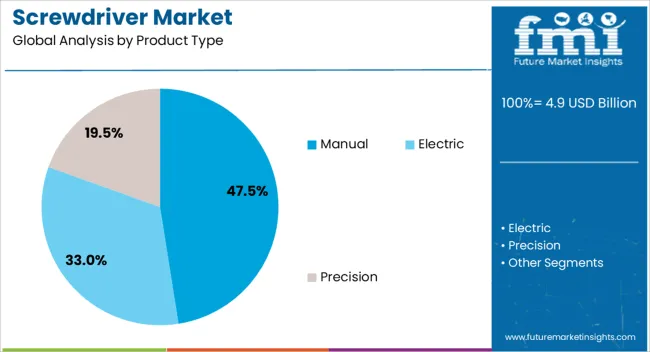
The manual product type segment is projected to account for 47.5% of the screwdriver market revenue share in 2025, establishing itself as the dominant product type. Its continued leadership is being driven by simplicity of design, affordability, and widespread usability across a range of tasks. Manual screwdrivers are favored for their precision, portability, and independence from power sources, making them essential in toolkits for both professionals and household users.
The absence of complex mechanisms reduces maintenance requirements and enhances longevity, which adds to their appeal in cost-sensitive markets. Growth in home renovation, repairs, and light assembly activities is reinforcing the demand for manual screwdrivers, especially in emerging economies where power tools may be less accessible.
Enhanced product ergonomics and material improvements, including magnetic tips and anti-slip handles, are also elevating user experience and driving brand differentiation As the market continues to emphasize practical and economical hand tools for varied applications, the manual segment is expected to maintain its lead in revenue contribution, especially within the DIY and general maintenance sectors.
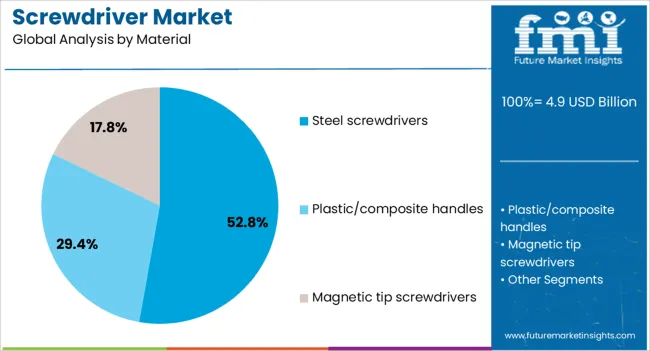
The steel screwdrivers segment is anticipated to represent 52.8% of the screwdriver market revenue share in 2025, making it the leading material category. This dominance is being reinforced by the strength, durability, and resistance to wear offered by steel, which enhances performance across both residential and industrial environments. Steel variants offer superior torque handling and reduced risk of tip deformation, characteristics that are essential for repetitive or high-stress applications.
The widespread availability of alloy and high-carbon steel options allows manufacturers to tailor products for specific use cases without compromising on strength or affordability. Consumer preference for reliable and long-lasting tools is supporting the adoption of steel screwdrivers in both developed and emerging markets.
Technological advancements in heat treatment and surface coating have improved the hardness and corrosion resistance of steel, further strengthening its market position As users increasingly seek tools that combine performance with longevity, the steel segment is expected to retain its leadership, especially in professional-grade and heavy-duty tool categories.
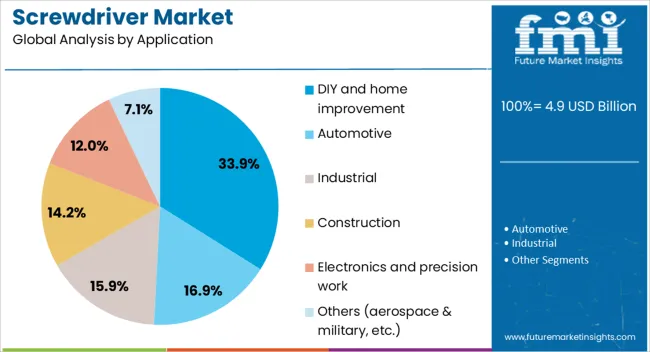
The DIY and home improvement segment is projected to hold 33.9% of the screwdriver market revenue share in 2025, making it the leading application area. This segment's leadership is being supported by the global rise in do-it-yourself culture, driven by increased home ownership, rising renovation activity, and widespread availability of tutorial content across digital platforms. Consumers are investing more in personal toolkits for minor repairs, furniture assembly, and decorative tasks, creating strong demand for easy-to-use and affordable screwdrivers.
The convenience and low cost of manual tools make them ideal for home users who prioritize versatility and simplicity over high-powered functionality. Retail and e-commerce channels are actively promoting screwdriver sets tailored for home use, which is further accelerating product accessibility and market penetration.
Additionally, the post-pandemic lifestyle shift toward home-centric living has led to a surge in home improvement spending, reinforcing long-term demand for basic hand tools As household consumers continue to value independence in maintenance and aesthetics, the DIY and home improvement segment is expected to sustain its role as the largest contributor to the screwdriver market’s overall growth.
The screwdriver market is experiencing growth as demand for both manual and powered screwdrivers continues to rise in various sectors, including automotive, construction, and DIY tools. As consumers and industries seek more efficient and versatile tools, the market is driven by technological advancements in cordless, battery-powered, and ergonomic designs. The rise in home improvement activities, coupled with increasing automation in industrial sectors, is propelling the need for screwdrivers that offer improved performance, longer battery life, and user comfort.
Challenges in the market include fluctuations in raw material costs, especially for steel and plastics, and intense competition from low-cost imports. Opportunities are emerging in the development of smart, IoT-enabled screwdrivers and tools that offer real-time feedback for improved precision and efficiency. Trends point to increased demand for multi-functional and customizable screwdrivers that can be used in a range of applications, from simple DIY tasks to complex industrial assembly lines.
The screwdriver market is being driven by increasing demand for ergonomic and high-performance tools, especially as consumers and professionals seek tools that reduce fatigue and improve productivity. The growing popularity of DIY projects, home improvement, and renovation activities is a key factor contributing to the market’s expansion, as people look for reliable and efficient tools for a range of applications. Additionally, the automotive and construction sectors are increasingly relying on power-driven screwdrivers to meet production demands, requiring tools that offer precision, high torque, and longer operational times. The demand for ergonomic designs that ensure ease of use and comfort, particularly in high-volume applications, is leading to innovations in screwdriver features, such as anti-slip grips and lightweight, durable materials.
The screwdriver market faces challenges related to the rising costs of raw materials, particularly metals such as steel and alloys used for screwdriver bits and handles. These fluctuations can affect production costs and impact pricing for both manufacturers and consumers. Additionally, regulatory constraints related to product safety and quality standards, especially in industries such as aerospace and automotive, demand continuous innovation and compliance.
Furthermore, the market is becoming increasingly competitive, with numerous low-cost imports from regions with less stringent regulations. Manufacturers are under pressure to offer high-quality products at competitive prices while maintaining compliance with safety standards and sustainability requirements. The complexity of integrating advanced features such as smart technology into screwdrivers also requires significant investment in research and development.
Opportunities in the screwdriver market are increasing with the growing demand for cordless, multi-functional, and smart tools. Cordless screwdrivers, powered by rechargeable batteries, are particularly popular due to their convenience, portability, and ease of use. Innovations in battery technology, such as lithium-ion batteries with longer life spans, are boosting the performance of cordless tools and making them more appealing to both professionals and DIY users.
Additionally, multi-functional screwdrivers that can accommodate different types of bits and serve multiple purposes are gaining popularity, offering greater versatility. The rise of smart screwdrivers, which use IoT and sensors to provide real-time feedback, data tracking, and enhanced precision, is opening new growth opportunities. As the demand for more efficient and high-tech tools grows, manufacturers that offer these advanced features are poised to capture a significant share of the market.
The screwdriver market is witnessing trends focused on customization, automation, and the integration of IoT technology. The demand for customizable screwdrivers, which allow users to switch out different heads or adjust the tool to fit various screws, is increasing. This trend caters to both DIY enthusiasts and professionals who require flexibility in their tools for a range of applications. Automation in industrial settings is driving demand for powered screwdrivers with high torque and precision, particularly in assembly lines and automated systems.
Additionally, the integration of IoT technology into screwdrivers is enabling manufacturers to offer smart tools that track usage, monitor battery life, and even alert users to maintenance needs. These trends are transforming the screwdriver market, making tools smarter, more adaptable, and capable of meeting the increasingly complex needs of both professionals and consumers.

| Country | CAGR |
|---|---|
| China | 6.3% |
| India | 5.9% |
| Germany | 5.4% |
| France | 4.9% |
| UK | 4.5% |
| USA | 4.0% |
| Brazil | 3.5% |
The global screwdriver market is projected to grow at a CAGR of 4.7% from 2025 to 2035. China leads the market with a growth rate of 6.3%, followed by India at 5.9% and France at 4.9%. The UK and USA show moderate growth rates of 4.5% and 4.0%, respectively. The demand for screwdrivers is driven by the expansion of the automotive, construction, and manufacturing sectors. The rise in DIY culture, home improvement projects, and the growing adoption of electric and cordless screwdrivers are also key drivers of the market. The analysis includes over 40 countries, with the leading markets shown below.
The screwdriver market in China is projected to grow at a CAGR of 6.3% from 2025 to 2035. Significant manufacturing base and booming industrial sectors, particularly automotive, electronics, and construction, are the primary drivers of this market. With an ever-expanding demand for power tools and hand tools, the need for high-quality screwdrivers is increasing in both commercial and residential applications. The rise in DIY culture and the growth of e-commerce platforms are also contributing to the market’s expansion.
As China continues to focus on automation and modernizing its manufacturing facilities, the demand for specialized screwdrivers, such as electric and pneumatic variants, is increasing. The rapid urbanization and infrastructure development in the country are fueling the need for efficient and durable tools for construction and maintenance purposes. The growing popularity of home improvement and repair tasks, along with innovations in ergonomic designs and advanced materials, is further driving the market’s growth.
The screwdriver market in India is set to grow at a CAGR of 5.9% from 2025 to 2035. As India’s industrial and construction sectors continue to expand, the demand for screwdrivers and other hand tools is increasing significantly. The rapid growth of the automotive, electronics, and home improvement sectors is contributing to the rise in demand for both manual and electric screwdrivers. With a growing middle class and an increased focus on urbanization, India is seeing an upsurge in DIY activities, leading to higher sales of screwdrivers through retail and online platforms.
As the country’s infrastructure projects progress, the need for high-quality tools for construction, assembly, and repair tasks is growing. The introduction of ergonomic, easy-to-use screwdrivers, particularly for home improvement enthusiasts, is expected to further boost the market. Furthermore, the growing emphasis on electric and cordless screwdrivers in industries such as automotive manufacturing is contributing to the market’s development.
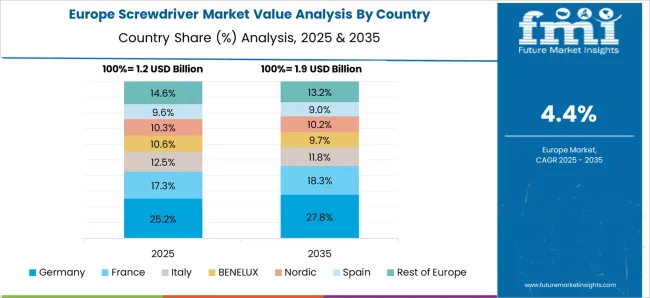
The screwdriver market in France is projected to grow at a CAGR of 4.9% from 2025 to 2035. As one of Europe’s largest industrial markets, France’s demand for screwdrivers is closely tied to the growth of sectors such as automotive, aerospace, and construction. The rise in DIY culture, coupled with an increase in home improvement and repair activities, is further boosting the demand for hand tools, including screwdrivers. Additionally, France’s focus on sustainable manufacturing and innovations in ergonomic designs is contributing to the growth of the market.
The demand for cordless, battery-operated screwdrivers is increasing, particularly in industrial applications, as they offer greater flexibility and efficiency. France’s construction boom and the continuous development of infrastructure projects are driving the need for specialized screwdrivers in assembly, installation, and maintenance tasks. As France continues to invest in its industrial base and push for energy efficiency in manufacturing, the screwdriver market is set for significant growth.
The UK’s screwdriver market is expected to grow at a CAGR of 4.5% from 2025 to 2035. The market is primarily driven by the demand from the automotive, manufacturing, and construction industries. The UK’s focus on infrastructure development, particularly in residential and commercial construction, is boosting the need for reliable hand tools such as screwdrivers. Furthermore, the rise in DIY activities and the growing trend of home improvement projects are expected to contribute to the growth of the market.
The popularity of electric screwdrivers and their increasing adoption in industrial sectors like automotive and electronics manufacturing is another factor driving market expansion. The UK is also experiencing a shift towards cordless and rechargeable screwdrivers that provide greater mobility and ease of use. In addition to this, the growing trend of e-commerce is making it easier for consumers to access a variety of screwdriver options, contributing to increased sales.

The USA screwdriver market is projected to grow at a CAGR of 4.0% from 2025 to 2035. The USA is witnessing steady growth in the screwdriver market, driven by the demand from industrial, automotive, and construction sectors. The expanding home improvement market, with a rise in DIY projects, is also contributing to the market’s growth, particularly in the retail and e-commerce sectors. The increasing demand for cordless and rechargeable screwdrivers, which are known for their convenience and efficiency, is another key driver.
As the USA continues to invest in infrastructure and manufacturing, the need for durable and reliable screwdrivers for construction, assembly, and repair work is rising. The demand for power tools is expected to grow, especially in the automotive and electronics industries, where precision and speed are essential. Furthermore, the growing trend of automation in manufacturing processes is contributing to the rise in electric and cordless screwdrivers in industrial settings.
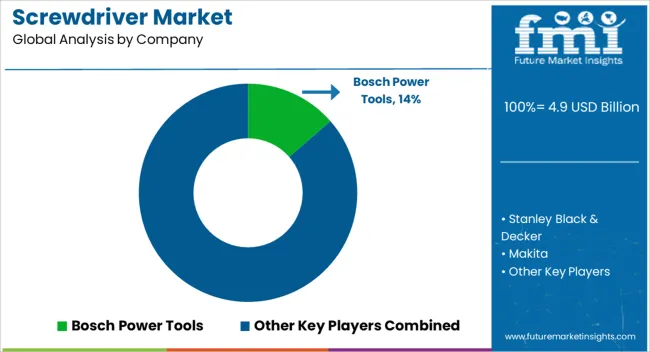
The screwdriver market is highly competitive, with various brands focusing on delivering tools that offer reliability, precision, and ergonomic designs for professional and DIY use. Bosch Power Tools is a leading player in the market, offering a wide range of electric and manual screwdrivers that combine high-performance motors with advanced technology, such as lithium-ion batteries for enhanced durability and ease of use. The company’s focus on innovation and quality positions it as a top choice for both industrial and home users. Stanley Black & Decker is another dominant force, known for its robust manual and powered screwdrivers.
The company offers ergonomic designs and high torque features, making its products ideal for heavy-duty tasks in construction, automotive, and general maintenance. Makita, a global leader in power tools, competes with a comprehensive range of corded and cordless screwdrivers, offering tools that emphasize precision, lightweight design, and long-lasting performance. Makita’s products cater to a wide range of sectors, from professional contractors to hobbyists. Snap-On offers high-quality, industrial-grade screwdrivers known for their durability and ergonomic features.
The brand targets professional tradesmen and mechanics who require reliable tools for daily, intensive use. Klein Tools and Irwin Tools focus on delivering manual screwdrivers designed for high precision and durability. Klein Tools emphasizes comfort and control with handles designed for improved grip and reduced hand fatigue, while Irwin’s screwdrivers are known for their long-lasting materials and strong performance. Wiha Tools, Proto Tool, and Felo Tools are other notable players, known for their premium, German-engineered tools that deliver exceptional performance in industrial and professional applications. Vessel, C.K Tools, and Park Tool cater to specialized screwdriver needs, with offerings designed for electronics, precision work, and bicycle maintenance, respectively.
Tajima Tools and Husky Tools focus on the DIY and professional market, providing affordable yet reliable screwdrivers for a range of tasks. Endevco also offers niche solutions, specializing in precision screwdrivers for specific industrial applications. Product brochures from these companies highlight key features such as ergonomic handles, anti-slip grips, precision tips, and the use of high-quality materials to ensure longevity and performance under pressure. Competitive strategies focus on offering a combination of quality, user comfort, and specialized features to appeal to both casual users and professionals across different industries.
| Item | Value |
|---|---|
| Quantitative Units | USD 4.9 billion |
| Product Type | Manual, Electric, and Precision |
| Material | Steel screwdrivers, Plastic/composite handles, and Magnetic tip screwdrivers |
| Application | DIY and home improvement, Automotive, Industrial, Construction, Electronics and precision work, and Others (aerospace & military, etc.) |
| Distribution Channel | Offline and Online |
| Regions Covered | North America, Europe, Asia-Pacific, Latin America, Middle East & Africa |
| Country Covered | United States, Canada, Germany, France, United Kingdom, China, Japan, India, Brazil, South Africa |
| Key Companies Profiled | Bosch Power Tools, Stanley Black & Decker, Makita, Snap-On, Klein Tools, Irwin Tools, Wiha Tools, Proto Tool, Felo Tools, Vessel, C.K Tools, Park Tool, Tajima Tools, Husky Tools, and Endevco |
| Additional Attributes | Dollar sales by screwdriver type, application, and material are growing, driven by ergonomic tool demand, DIY trends, and precision needs, with strong market growth in North America, Europe, and Asia-Pacific |
The global screwdriver market is estimated to be valued at USD 4.9 billion in 2025.
The market size for the screwdriver market is projected to reach USD 7.8 billion by 2035.
The screwdriver market is expected to grow at a 4.7% CAGR between 2025 and 2035.
The key product types in screwdriver market are manual, electric and precision.
In terms of material, steel screwdrivers segment to command 52.8% share in the screwdriver market in 2025.






Full Research Suite comprises of:
Market outlook & trends analysis
Interviews & case studies
Strategic recommendations
Vendor profiles & capabilities analysis
5-year forecasts
8 regions and 60+ country-level data splits
Market segment data splits
12 months of continuous data updates
DELIVERED AS:
PDF EXCEL ONLINE

Thank you!
You will receive an email from our Business Development Manager. Please be sure to check your SPAM/JUNK folder too.
Chat With
MaRIA